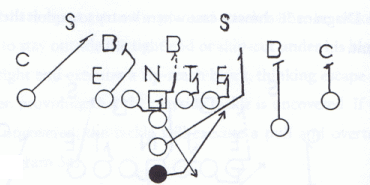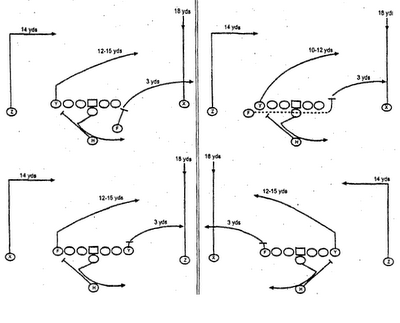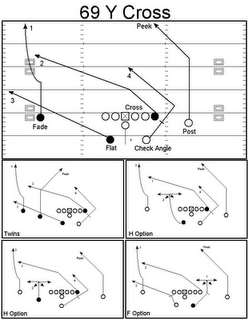The Zone Scheme
Zone running actually encompass two different plays-the inside and outside zone. Ohio State primarily runs the inside zone, but will employ both.
Inside Zone
Below is a diagram of the basic inside zone play, as well as a clip of Ohio State running inside zone. (H/T: Smart Football):

" width="640" height="385">
More, after the Jump:

To break this down further, Smart Football provides an excellent explanation of the zone scheme that I will not try to duplicate, but merely cite in full.
On zone plays, the linemen keep the same blocking schemes, regardless of how many tight-ends or wide receivers they use . . . On all zone runs, the linemen must ask, "Am I ‘covered’ (is there a guy directly in front of me, aside from a linebacker set back a few years)? Or am I ‘uncovered’ (there is no one directly in front of me)?"
If "covered," there is very little "zoning" at all: The lineman’s job is to block the guy in front of them. Fans, commentators, and even coaches often overcomplicate things. The "zone" aspect comes in with "uncovered" linemen. If "uncovered," the lineman must step "playside" — i.e. the side the run is going to — and help double-team the defensive linemen along with his "covered" cohort. Once the two of them control that down defensive lineman, one of the offensive linemen slides off to hit a linebacker. It’s not that complicated. Indeed, let’s say the five offensive linemen are covered by five defensive linemen. In that case, each guy (save for maybe the backside offensive tackle) will just block the guy in front of them — there is no "zoning" at all.For the inside zone, the uncovered linemen are going to combo block more vertically.
On the inside zone the runner aims for the outside hip of the offensive guard. Now, his read can vary by team. Some teams have him read that three technique defensive tackle, while others have him read the middle or "Mike" linebacker. In both cases the idea is for him to find the "vertical" crease — either straight playside off the guard’s hip or backside on a cutback.For those interested, here is a more in-depth discussion of offensive line rules in the zone game. Zone rushing plays both simply assignments for the offensive linemen, and provide the opportunity for tailbacks with good vision to find the hole, taking pressure off the offensive line.
Lead Zone
Specific to Ohio State, it is important to note that the zone play can be run as a 'lead zone.' This simply means that out of the I formation, the fullback will lead block for the tailback rather than block backside. The offensive line's assignments stay the same. What that means in practical terms is rather than set up a particular linebacker for an 'ISO' block, the O-Line is going to block like the fullback is not going to be there, and then the fullback simply picks up whatever defensive player shows. The fullback is going to aim for the same place as the tailback--the outside hip of the playside guard. Generally he will block a playside linebacker. Ohio State employs the lead zone as much, if not more, than the 'pure' inside zone--it is one of the most frequent OSU run plays. Below are clips of Ohio State running lead zone.
" width="480" height="385">
" width="640" height="385">
Outside Zone
As noted, OSU employs the outside zone far less than an exclusively pro-style zone team. Nonetheless, it is worth saying a quick word. Here, again, is Smart Football:
It gets a little trickier regarding the difference between inside and outside zones, though this involves technique, not assignment. (And this is where the rabbit hole begins, as there are a zillion coaching points to doing this well, but that is better discussed in a coaching DVD rather than this overview.)Here is an accompanying diagram of the scheme:
On outside zone plays, the offensive linemen take a bit more of a lateral first step and try to reach the defender across from them. He wants to get his body between the defender and the sideline. It’s important to note, however, that the very act of trying to reach the defender often gets him flying to the sideline, at which time the offensive lineman can then switch to driving the defender to the sideline. The runningback aims for a point outside the tight-end, though he can cut it upfield wherever a seam appears.

As one can see, the outside zone is attacking the outside hip of the tackle box. The outside zone is an outside to cut-up play, inside zone is a play side to cutback play.
Naked Bootleg
From under center, the perfect accompanying play-action pass to the zone play is the naked bootleg. As I previously noted, Ohio State emphasized this play during the jersey scrimmage, and I expect it to be a major part of the offense this season, as it utilizes the combination of OSU's inside run game, and the outside pass/run threat presented by Terrelle Pryor.

The top-left diagram demonstrates what Ohio State employed during the jersey scrimmage. Ohio State would fake the inside zone from some variation of the I-formation, where the fullback would carry out his backside block and then release into the flat. Ohio State employed a weak-side flood route combination off the inside zone bootleg.

The combination of the inside zone run play and naked bootleg attacking the backside flat will be a primary play-combination for OSU this season.
This series can also be seen at AlongtheOlentangy.com, where I will be posting my game breakdown and other thoughts this season.
No comments:
Post a Comment